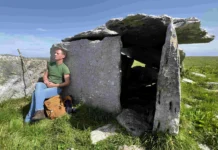The use of Cleggan Airstrip in the ‘Alcock and Brown’ centenary celebrations of the first ever non-stop transatlantic flight taking place in Clifden this summer has been approved.
John Alcock and Arthur Brown made the first non-stop transatlantic flight in a modified WWI bomber in June 1919.
The two airmen flew from Newfoundland in Canada, exposed to wind, rain, snow, and ice, before crash landing in a bog in Derrygilmleigh outside Clifden.
The ‘Alcock and Brown 100th anniversary festival will see a full re-enactment of the 1919 landing and part of the celebrations include a ‘fly in’ involving several aircraft at the Cleggan Airfield on Saturday, June 15.
As the airstrip is owned by the Department of Culture, Heritage and the Gaeltacht, government permission had to be sought to make use of it.
Galway TD and Minister for the Irish Language, the Gaeltacht and the Islands Seán Kyne granted that permission this week.
Cathaoirleach of Galway county council Eileen Mannion said she was delighted that Minister Kyne has seen fit to approve Cleggan for use in the festival.
“Clifden and North West Connemara has the privilege of being closely associated with the first non-stop transatlantic flight, a momentous milestone in the history of aviation.
“The approval from Minister Kyne and the Department of Culture, Heritage and the Gaeltacht for the use of the airfield will enhance the wonderful festival that the ‘Alcock and Brown 100’ organisers have planned.”
“The re-enactment of the 1919 landing and the ‘fly in’, involving a number of aircraft will bring to life this feat of engineering for the communities of Connemara and beyond.”
A famous statue of the two men which normally resides at Heathrow Academy has been lent out for this celebration and can be seen at the Abbeyglen Castle Hotel in Clifden up until June 25.

Clifden already commemorates the historic flight with two monuments close to the 1919 landing site.
One is a white cairn at the spot where they radioed their success to London from a nearby Marconi radio station, and the other is a sculpture of the plane’s tail fin at Errislannan Hill two kilometres away.













